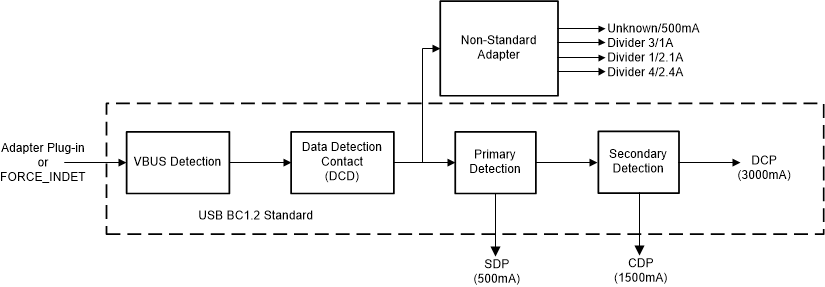SLUSD88A March 2019 – June 2019 BQ25886
PRODUCTION DATA.
- 1 Features
- 2 Applications
- 3 Description
- 4 Revision History
- 5 Device Comparison Table
- 6 Pin Configuration and Functions
- 7 Specifications
-
8 Detailed Description
- 8.1 Overview
- 8.2 Functional Block Diagram
- 8.3
Feature Description
- 8.3.1 Device Power-On-Reset
- 8.3.2 Device Power Up from Battery without Input Source
- 8.3.3 Device Power Up from Input Source
- 8.3.4 Input Current Optimizer (ICO)
- 8.3.5 Buck Mode Operation from Battery (OTG)
- 8.3.6 PowerPath Management
- 8.3.7 Battery Charging Management
- 8.3.8 Status Outputs
- 8.3.9 Input Current Limit on ILIM Pin
- 8.3.10 Voltage and Current Monitoring
- 8.3.11 Thermal Regulation and Thermal Shutdown
- 8.3.12 Battery Protection
- 8.4 Device Functional Modes
- 9 Application and Implementation
- 10Power Supply Recommendations
- 11Layout
- 12Device and Documentation Support
- 13Mechanical, Packaging, and Orderable Information
Package Options
Mechanical Data (Package|Pins)
- RGE|24
Thermal pad, mechanical data (Package|Pins)
- RGE|24
Orderable Information
8.3.3.2.1 D+/D– Detection Sets Input Current Limit
The BQ25886 contains a D+/D- based input source detection to program the input current limit. The D+/D- detection has three major steps: Data Contact Detect (DCD), Primary Detection, and Secondary Detection.
 Figure 13. D+/D- Detection Flow
Figure 13. D+/D- Detection Flow Table 2. Non-Standard Adapter Detection
| NON-STANDARD ADAPTER | D+ THRESHOLD | D– THRESHOLD | INPUT CURRENT LIMIT |
|---|---|---|---|
| Divider 1 | VD+ within V2P8_VTH | VD– within V2P0_VTH | 2.1 A |
| Divider 3 | VD+ within V2P0_VTH | VD– within V2P8_VTH | 1 A |
| Divider 4 | VD+ within V2P8_VTH | VD– within V2P8_VTH | 2.4 A |
Table 3. Input Current Limit Setting from D+/D– Detection
| D+/D– DETECTION | INPUT CURRENT LIMIT (IINDPM) |
|---|---|
| USB SDP (USB500) | 500 mA |
| USB CDP | 1.5 A |
| USB DCP | 3.0 A
|
| Divider 3 | 1 A |
| Divider 1 | 2.1 A |
| Divider 4 | 2.4 A |
| Unknown 5V Adapter | 500 mA |